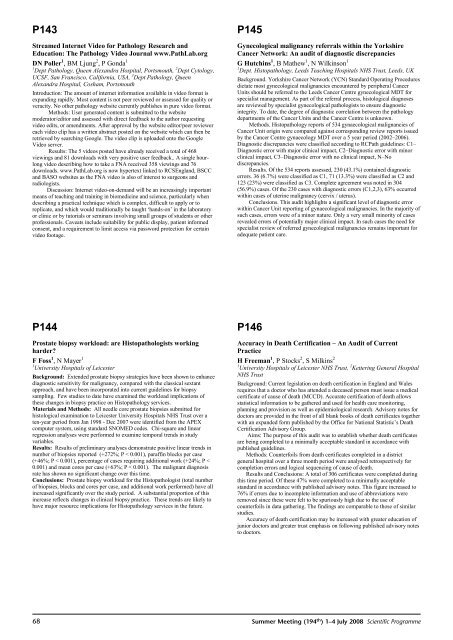2008 Summer Meeting - Leeds - The Pathological Society of Great ...
2008 Summer Meeting - Leeds - The Pathological Society of Great ...
2008 Summer Meeting - Leeds - The Pathological Society of Great ...
Create successful ePaper yourself
Turn your PDF publications into a flip-book with our unique Google optimized e-Paper software.
P143Streamed Internet Video for Pathology Research andEducation: <strong>The</strong> Pathology Video Journal www.PathLab.orgDN Poller 1 , BM Ljung 2 , P Gonda 11 Dept Pathology, Queen Alexandra Hospital, Portsmouth, 2 Dept Cytology,UCSF, San Francisco, California, USA, 3 Dept Pathology, QueenAlexandra Hospital, Cosham, PortsmouthIntroduction: <strong>The</strong> amount <strong>of</strong> internet information available in video format isexpanding rapidly. Most content is not peer reviewed or assessed for quality orveracity. No other pathology website currently publishes in pure video format.Methods: User generated content is submitted to the websitemoderator/editor and assessed with direct feedback to the author requestingvideo edits, or amendments. After approval by the website editor/peer reviewereach video clip has a written abstract posted on the website which can then beretrieved by searching Google. <strong>The</strong> video clip is uploaded onto the GoogleVideo server.Results: <strong>The</strong> 5 videos posted have already received a total <strong>of</strong> 468viewings and 81 downloads with very positive user feedback.. A single hourlongvideo describing how to take a FNA received 358 viewings and 76downloads. www.PathLab.org is now hypertext linked to RCSEngland, BSCCand BASO websites as the FNA video is also <strong>of</strong> interest to surgeons andradiologists.Discussion: Internet video-on-demand will be an increasingly importantmeans <strong>of</strong> teaching and training in biomedicine and science, particularly whendescribing a practical technique which is complex, difficult to apply or toreplicate, and which would traditionally be taught ‘hands-on’ in the laboratoryor clinic or by tutorials or seminars involving small groups <strong>of</strong> students or otherpr<strong>of</strong>essionals. Caveats include suitability for public display, patient informedconsent, and a requirement to limit access via password protection for certainvideo footage.P145Gynecological malignancy referrals within the YorkshireCancer Network: An audit <strong>of</strong> diagnostic discrepanciesG Hutchins 1 , B Mathew 1 , N Wilkinson 11 Dept. Histopathology, <strong>Leeds</strong> Teaching Hospitals NHS Trust, <strong>Leeds</strong>, UKBackground. Yorkshire Cancer Network (YCN) Standard Operating Proceduresdictate most gynecological malignancies encountered by peripheral CancerUnits should be referred to the <strong>Leeds</strong> Cancer Centre gynecological MDT forspecialist management. As part <strong>of</strong> the referral process, histological diagnosesare reviewed by specialist gynecological pathologists to ensure diagnosticintegrity. To date, the degree <strong>of</strong> diagnostic correlation between the pathologydepartments <strong>of</strong> the Cancer Units and the Cancer Centre is unknown.Methods. Histopathology reports <strong>of</strong> 534 gynaecological malignancies <strong>of</strong>Cancer Unit origin were compared against corresponding review reports issuedby the Cancer Centre gynaecology MDT over a 5 year period (2002–2006).Diagnostic discrepancies were classified according to RCPath guidelines: C1–Diagnostic error with major clinical impact, C2–Diagnostic error with minorclinical impact, C3–Diagnostic error with no clinical impact, N–Nodiscrepancies.Results. Of the 534 reports assessed, 230 (43.1%) contained diagnosticerrors. 36 (6.7%) were classified as C1, 71 (13.3%) were classified as C2 and123 (23%) were classified as C3. Complete agreement was noted in 304(56.9%) cases. Of the 230 cases with diagnostic errors (C1,2,3), 63% occurredwithin cases <strong>of</strong> uterine malignancy (cervix / uterus).Conclusions. This audit highlights a significant level <strong>of</strong> diagnostic errorwithin Cancer Unit reporting <strong>of</strong> gynaecological malignancies. In the majority <strong>of</strong>such cases, errors were <strong>of</strong> a minor nature. Only a very small minority <strong>of</strong> casesrevealed errors <strong>of</strong> potentially major clinical impact. In such cases the need forspecialist review <strong>of</strong> referred gynecological malignancies remains important foradequate patient care.P144Prostate biopsy workload: are Histopathologists workingharder?FFoss 1 , N Mayer 11 University Hospitals <strong>of</strong> LeicesterBackground: Extended prostate biopsy strategies have been shown to enhancediagnostic sensitivity for malignancy, compared with the classical sextantapproach, and have been incorporated into current guidelines for biopsysampling. Few studies to date have examined the workload implications <strong>of</strong>these changes in biopsy practice on Histopathology services.Materials and Methods: All needle core prostate biopsies submitted forhistological examination to Leicester University Hospitals NHS Trust over aten-year period from Jan 1998 - Dec 2007 were identified from the APEXcomputer system, using standard SNOMED codes. Chi-square and linearregression analyses were performed to examine temporal trends in studyvariables.Results: Results <strong>of</strong> preliminary analyses demonstrate positive linear trends innumber <strong>of</strong> biopsies reported (+272%; P < 0.001), paraffin blocks per case(+46%; P < 0.001), percentage <strong>of</strong> cases requiring additional work (+24%; P













